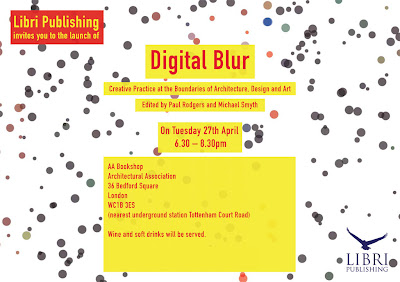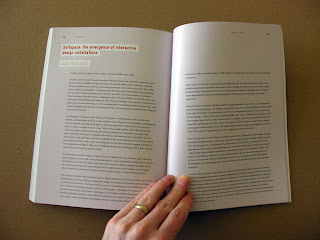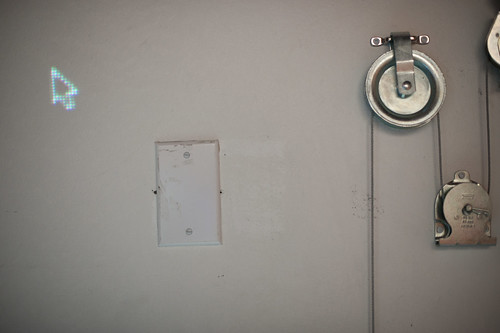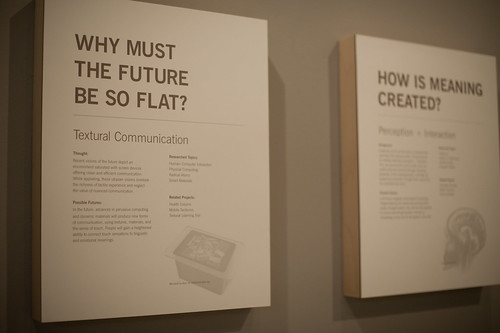…and apparently available only in the UK presently. John Marshall and I have a manifesto-y essay towards the end of this.
Tag: Digital Blur
Week Ending 04232010
Well, I missed the Week Ending last week so I’ll capture a couple of the things that happened then, now.
There were a cacophony of tasks to be done, some fun, some that should’ve been fun, and all that tipped me into a level of activity-stress that translated into too little sleep and various physical ailments. These aren’t complaints at all — just a note-to-self to either learn how to manage multiple concurrent fun commitments, or spread them out like butter on a baguette.
There was a Skype lecture between here and Seoul given for a design seminar at Art Center Nabi. That was a curious thing — to lecture with the audience *sort of* there. Basically akin to talking to yourself, or rehearsing a lecture. I’m not sure I could do that again, comfortably. Aside from the challenges of dialing back my weird circumlocutions and the litany’s I dispense midtalk while trying to remember what my next point should be, or might’ve been had I not forgotten it moments earlier — it’s just a bit impersonal. Or maybe it was just the fact that it was 11 in the evening after a proper day in the studio and I just wanted to have a belt and fall asleep.
It was a roilingly active week in the studio, with this sense that there was an intense and focused round of design work on the horizon, and the sort — systemically speaking — that Nicolas and I had pondered would be an ideal way of working, especially after we both made a turn from academic and formal approaches to making things. Looking at the world obliquely, learning from new perspectives and points-of-view, redefining or differently defining what *success and *achievement might be — not just up-and-to-the-right. Somewhat in line with this talk at Lift in 2008 7.5 Rules for Working Together. I’m quite excited by the prospect this bit of work allows for a more skunky/stinky untoward refrain to the normal ways in which things are done. A bit — tip-of-the-spear actions.
Via our weekly Skype, forward progress continues on the iPhone edition of The Drift Deck, with Jon Bell and Dawn Lozzi taking that bull by its horns. Of course, we’re all excited by the prospect of a second life for The Drift Deck — and curious by the translation of a physical deck of cards into its electronic kin. There are a couple of iterations already. Engaged simplicity is the goal. There were discussions that I prompted around game mechanics — don’t know why I, in particular, would be bringing this topic up — and I think the conclusion is that it is what it is. The deck, is the deck.
The Apparatus for Capturing Other Points of View was sent to LABoral Centro de Arte y Creación Industrial, where it — and the material produced — will be in an exhibition next month. ((More on that in the appropriate week note)). That was an epic undertaking — I mean the operational mishegoss of sending an 8 foot pole to Spain. DHL took it in stride..literally.
@ibogost was a house guest as he had some weird lecture to do, and that meant snifters of Port in the kitchen talking about #OOO, the shapes of things and a discussion of knob-turned-to-11 materializations of social practices, which is something I’m trying to figure out how to talk about beyond just saying that and, as it turns out — it might make more sense to materialize the “talk” about that than to just talk about it. And he’s on this *Carpentry thing, which I think would be our point of contact on this whole Object-Oriented Ontology vector he and his 12 friends appear to be all hopped-up about. ((They had a seminar on it last week — I hope it was captured in something ≫ 140 character tweets. ((That’s the 12 other people all hopped up on #OOO, and I might be number 13 based on our boozy conversation.))
This actual week — all that except @ibogost’s visit was the week before — started off with performing the duties of guest critic for the Art Center College of Design’s Media Design Program’s thesis year projects. That was a completely full day — almost 10 hours — of crits. Good work all around, with some curiously strong failures and seductively tenuous successes. Despite the work, which I certainly enjoyed in total, the crits were lots of fun, tiring and engaged. That culture of this sort of design critique was something sorely missing at the Interactive Media Program, leastways when I was there and I reflected on that contrast in the back of my mind. It’s something that is a way of working in the studio, frankly and only adds to the work. Patient, mindful intervention; conscientious and respectful criticisms; hard intellectual and creative framing that is only meant to make the work better.
The rest of the week consisted of some low-key efforts to have Design engage Research differently. We’ve been doing roughly monthly, completely casual, completely self-initiated link-ups with the Research part of the organization, mostly because there are friends there and it’s nice to share and discuss projects. Never really looking for *actionable points of collaboration — the collaboration is in the discussions. For me professionally, The Laboratory is much more interested in finding ways of working than specific things to work on, although sometimes specific things to work on are the ways you understand how different disciplines do what they are disciplined to do. Later in the week when there was another link-up, I found myself a bit sensitive to these different ways of working — Research wants a particular kind of action to unfold rather than action-as-reflection. It’s all sorted out somehow — we just need to make it, and that will be that. Rather than the *crit and the conversations that wonder in the first instance — why this and in this instantiation? Or — let’s throw out all that *work and start fresh with the possibility that we will come back to it at some point. Or, the journey rather than the finalé.
It all ended with a confidential review and excitement about the approaching National Pretzel Day, as well as the book launch of Digital Blur at The Architectural Association on Tuesday evening.
Digital Blur Book Launch At Architectural Association April 27

This book Digital Blur — in which John Marshall and I have a sort of drunken, double-bandolier-wearing bandito-style essay on *undisciplinarity — will launch on April 27th in London at The Architectural Association Bookshop, which is a fantastic bookshop anyway so you basically can’t loose.
if anyone goes..i wouldn’t mind a photo of the event just to show my mother what i have wrought, in my own humble, minuscule way.
Digital Blur: Creative Practice at the Boundaries of Architecture, Design and Art’
On behalf of Libri Publishing I am delighted to invite you to the launch of Paul Rodgers and Michael Smyth’s new book.
A formal invitation is attached.
The launch is being held on: Tuesday 27 April 18.30 – 20.30
The AA Bookshop
Architectural Association
36 Bedford Square
London
WC1B 3ES
The nearest underground station is Tottenham Court Road.
Wine and soft drinks will be served. We hope you will be able to join us.
Please R.S.V.P. by email to: julie.farmer@libripublishing.co.uk
Continue reading Digital Blur Book Launch At Architectural Association April 27
Undisciplinarity (essay in book)
The book that resulted from the ‘inter_multi_trans_actions: emerging trends in post-disciplinary creative practice’ symposium at Napier University in Edinburgh, Scotland on Thursday 26 June, 2008 is nearing publication.
The book ‘Digital Blur: Creative Practice at the Boundaries of Architecture, Design and Art’ edited by Paul Rodgers and Michael Smyth will now be published by Libri Publishing following Middlesex University’s decision to close Middlesex University Press.
According to Amazon the book is due on 31 March, 2010.
The book contains an essay by John Marshall and myself that is preambled thus:
Marshall and Bleecker, in their essay, propose the term ‘undisciplinary’ for the type of work prevalent in this book. That is, creative practice which straddles ground and relationships between art, architecture, design and technology and where different idioms of distinct and disciplinary practices can be brought together. This is clearly evident in the processes and projects of the practitioners’ work here. Marshall and Bleecker view these kinds of projects and experiences as beyond disciplinary practice resulting in a multitude of disciplines ‘engaging in a pile-up, a knot of jumbled ideas and perspectives.’ To Marshall and Bleecker, ‘undisciplinarity is as much a way of doing work as it is a departure from ways of doing work.’ They claim it is a way of working and an approach to creating and circulating culture that can go its own way, without worrying about working outside of what histories-of-disciplines say is ‘proper’ work. In other words, it is ‘undisciplined’. In this culture of practice, they continue, one cannot be wrong, nor have practice elders tell you how to do what you want to do and this is a good thing because it means new knowledge is created all at once rather than incremental contributions made to a body of existing knowledge. These new ways of working make necessary new practices, new unexpected processes and projects come to be, almost by definition. This is important because we need more playful and habitable worlds that the old forms of knowledge production are ill-equipped to produce. For Marshall and Bleecker, it is an epistemological shift that offers new ways of fixing the problems the old disciplinary and extra-disciplinary practices created in the first place. The creative practitioners contained within the pages of this book clearly meet the ‘undisciplinary’ criteria suggested by Marshall and Bleecker in that they certainly do not need to be told how or what to do; they do not adhere to conventional disciplinary boundaries nor do they pay heed to procedural steps and rules. However, they know what’s good, and what’s bad and they instinctively know what the boundaries are and where the limits of the disciplines lie.
”
(Via Designed Objects.)
















